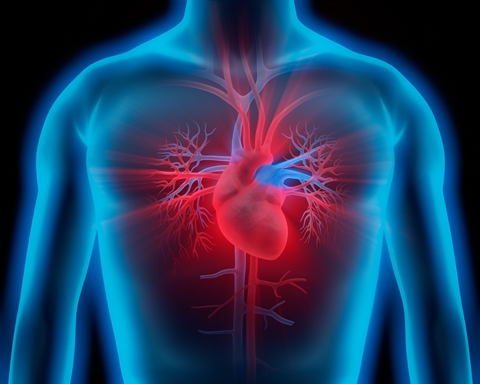
Myocardial infarction (also known as Heart Attack) is usually caused by a blood clot that prevents flow to part of the heart muscle. The lack of oxygen causes tissue death, which leads to scar tissue formation that ultimately weakens and reduces heart functionality.
Blood clots are usually formed due to fatty patches developing within the arteries, although other causes are possible. 146,000 people in the UK have myocardial infarction every year, with the estimated annual economic burden of post acute myocardial infarction heart failure estimated at between £125 and £453 million. Cost per patient depends on the severity of disablement and the increased risk of heart failure, which in turn increases the required incapacity treatment and help. There is also considerable cost to the economy of reduced productivity, time off work and premature retirement for those under the age of 65.
Current treatment focuses on dissolving the clot, unblocking the artery, controlling the heart rate and provision of oxygen.
Clinical Trial on the Stem Cell Therapy for Heart Attack
Bone marrow-derived stem cells have been used to treat patients by repairing the damage to the muscle. There have been 13 trials to date using this stem cell source. One clinical trial has also been completed using autologous cells derived from heart biopsies.
These trials are all in adult patients who do not have cord blood stored (NCT01467232). Results published after a 2-year follow up show a sustained positive effect, with 9 out of 20 patients showing new heart tissue replacing scar tissue. There is one current clinical trial using cord blood-derived mesenchymal stem cells (MSC), but data has yet to be published. There is also a European-funded project (EU FP7-BAMI) assessing the efficacy of stem cell therapies versus other treatments, This is assessing 33 trials comprising 1,700 patients, with follow up for several years.
Cell Line
Work has been ongoing to try and create new cardiac parts such as heart valves from autologous stem cell sources. Whilst this is possible in theory, it has not yet surpassed the need for bioscaffolds and biomaterials.
Current research at the University of East Anglia is looking into the development of a heart in utero, and hopes to understand how different heart cells form. Other research has looked into the prevention of scar tissue formation. This is linked to the ability of haematopoietic cells to produce blood-carrying structures.
Under the leadership of Mark Sussman in San Diego, a new Integrated Regenerative Research Institute has been set up with the aim of “trying to turn back the aging clock of your heart”.
Animal Studies
Both mice and rats have been used as models to assess cord blood-derived stem cell therapies for myocardial infarction. This shows a positive effect, but has yet to show the mechanism of that effect.
In summary, myocardial infarction is the leading cause of death in the developed world. It is both a disease in its own right and a secondary complication of other diseases. Currently, the use of stem cells is seen as key to providing novel treatments and to understanding the mechanisms of repair.
{{cta(‘3fe0aac7-7562-46dc-b8b9-c706d9cfd6b1’)}}


